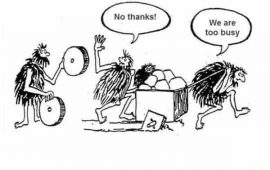Your Goals Require a Systems Thinking Approach
For a few minutes, let’s take a step back and look at your business from a 30,000 foot view.
Would you agree that your business is a blended interaction of inter-related moving parts? Those parts might include an owner, employees, products, finances, products, inventory, various offerings, services, processes, habits, methods, rituals, culture, values etc…
Approach Your Goals Strategically
Taking a look at just one part of the system without considering the effect on others would be ….well… unsophisticated to say the least.
Simple Example
I was brought in to work with a company that had very high employee turnover. To hire new employees, they offered them the best schedules – the money-making schedules. It seemed like a good idea to attract new hires.
The flip side was that the experienced employees, the ones who had been there longer, got the worst schedules and lost money. This situation created a serious lack of motivation for the more experienced employees, as they saw their income drop as the new folks filled the good shifts. Many of them left which perpetuated the situation.
The solution was a culture shift and mindset adjustment, that only took a couple weeks to see results.
As defined by Margaret Rouse: Systems thinking is a holistic approach to analysis that focuses on the way that a system’s constituent parts interrelate and how systems work over time and within the context of larger systems.
Your organization is a system, but let’s look at another system: your car.
A car is a system in that it takes in resources converts those resources thru a number of processes and produces a valuable output. We enjoy that output in terms of comfort, speed, security, or just getting from point A to point B.
If a warning light comes on, there are multiple possible causes; battery, alternator, a bulb, a faulty wire etc… but basically a breakdown in the system.
Related: Advantages of Micro Productivity
In an organization, occasionally something will not perform to standards or objectives will not be met. If the same problem is recurring and the same ineffective “solution” is applied then we have to start thinking that the root of the problem is something different. Too often, we work on the effect and not the cause. Too often, we work on what we can visibly see and measure rather than looking deeper.
To effect lasting change, transformational change of the underlying cause of the problem has to be addressed.
I have seen where a manager with a fixed and rigid mind set was actually the problem. His lack of flexibility to entertain that there may be a root cause below what he was trying to fix caused the problem to resurface again and again. He would say something like: “This is the third time this year we have this problem and I’ve been able to fix it each time…this is what you need to do.” It reminds me of the guy who said “sure I can quit smoking, I already quit 5 times”.
As with individuals, it is with companies; working on the symptoms can get you an immediate result but the symptoms will reemerge if the underlying cause is not addressed.
Sometimes…. A Quick Fix
There are times when you need a quick fix. There are emergency situations where decisions based on short term results are absolutely necessary. What I am saying is do not run your life or your business in crisis mode; let it be the exception and not the rule.
Most of us do not operate in a vacuum. Marketing affects Sales, Sales affects Support, and the cycle continues.
A systems approach would ask that you always consider the side effects and possible collateral damage to changes, quick fixes, and “easy” solutions. A systems approach would also ask that challenges be met with a holistic approach that will solve the issue at hand and fix the underlying cause.
While in Brazil, I had a mastermind group that allowed me to run ideas by other business owners. The group was composed of business people from different industries and backgrounds. Discussing my business ideas and challenges and getting their input was invaluable. They helped tremendously with systems thinking, as sometimes I seemed to not see the forest for the trees.

- What is your most important goal this month for your business?
- How will achieving that effect the rest of your business?
- What resources will be moved around so that you can accomplish that goal?
